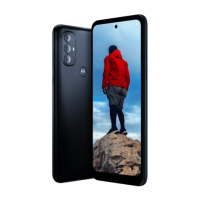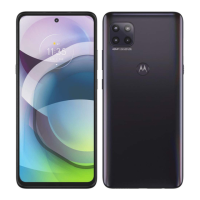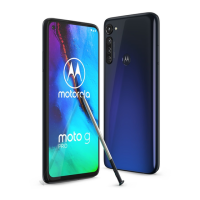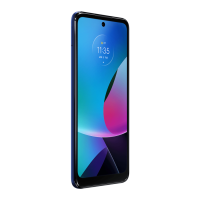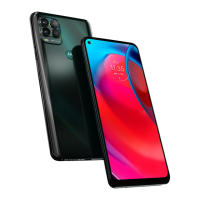Safety, regulatory & legal
safe, smart, protected
Battery use & safety
Battery use & safety
Warning:
Your mobile device contains a battery that should only be removed by a
Motorola-approved service centre or recycler.
•
Don't try to remove or replace the battery yourself. Attempting to remove or replace the
battery may damage the battery and may cause burning and injury.
•
Don't try to take apart or fix your phone. Attempting to take apart or fix your phone may
damage the battery and may cause burning and injury.
•
Don't crush, bend or expose your phone to heat or liquid. This may damage the battery
and may cause burning and injury.
Battery charging
Battery charging
Notes for charging your product's battery:
•
During charging, keep your mobile device and charger near room temperature for
efficient battery charging.
•
New batteries are not fully charged.
•
New batteries or batteries stored for a long time may take more time to charge.
•
Motorola batteries and charging systems have circuitry that protects the battery from
damage from overcharging.
Third party accessories
Third party accessories
Using third party accessories, including but not limited to batteries, chargers, headsets,
covers, cases, screen protectors, and memory cards, may impact your mobile device’s
performance. Motorola recommends use of a Motorola-branded charger for the best
charging experience. Using a non-Motorola battery or charger may present a risk of fire,
explosion, leakage, or other hazard. Motorola’s warranty doesn’t cover damage to the phone
caused by non-Motorola batteries and/or chargers, but third party chargers may be used
without impacting your warranty, provided they meet CE marking requirements and support
the USB Battery Charging Specification 1.2.
Note:
CE marking requirements may be confirmed through the European Commission
(
ec.europa.eu/enterprise/index_en.htm
). The USB Battery Charging Specification
1.2 is set by the USB Implementers Forum, Inc. (
www.usb.org
). These requirements
ensure that your charger meets appropriate criteria for use.
Driving precautions
Driving preca utions
Responsible and safe driving is your primary responsibility when driving a vehicle. Making
calls or using applications while driving may cause distraction, and may be prohibited or
restricted in certain areas—always obey local laws and regulations for the use of mobile
devices and accessories in the vehicle.
While driving, ALWAYS:
•
Keep your eyes on the road.
•
Use a hands-free device if available or required by law in your area.
•
Enter destination information into a navigation device
before
driving.
•
Use voice-activated features (such as voice dial) and speaking features (such as audible
directions), if available.
•
Concentrate on driving, and stop using the mobile device if you can't concentrate.
Pull over safely before using your mobile device to send messages, surf the web or use other
applications.
Seizures, blackouts & eyestrain
Seizures, b lackouts & eyestrai n
To reduce eyestrain and avoid headaches, it is always a good idea to hold the screen at a
comfortable distance from your eyes, use in a well-lit area and take frequent breaks.
Some people may be susceptible to seizures or blackouts (even if they have never had one
before) when exposed to flashing lights or light patterns, such as when playing video games
or watching videos with flashing-light effects.
Discontinue use and consult a doctor if any of the following symptoms occur: seizures,
blackout, convulsion, eye or muscle twitching, loss of awareness or disorientation.
Caution about high volume usage
High Volu me
Warning:
Exposure to loud noise from any source for extended periods of time
may affect your hearing. The louder the sound, the less time is required before
your hearing could be affected. To protect your hearing:
•
Limit the amount of time you use headsets or headphones at high volume.
•
Avoid turning up the volume to block out noisy surroundings.
•
Turn the volume down if you can't hear people speaking near you.
If you experience hearing discomfort, including the sensation of pressure or fullness in your
ears, ringing in your ears or muffled speech, you should stop listening to the device through
your headset or headphones and have your hearing checked.
Repetitive motion
Repetitive motion
When you repetitively perform actions, such as pressing keys, you may experience
discomfort in your hands, arms, shoulders, neck or other parts of your body. If you continue
to have discomfort during or after such use, stop use and see a doctor.
Children
Child ren
Keep your mobile device and its accessories away from small children.
These products
are not toys and may be hazardous to small children. For example, a choking hazard may exist
for small, detachable parts.
Supervise access.
If a child does use your mobile device, monitor their access to help
prevent loss of data or unexpected charges for data or application purchases.
Safety, regulatory & legal
Battery use & safety
Battery charging
Third party accessories
Driving precautions
Seizures, blackouts & eyestrain
High Volume
Repetitive motion
Children
Glass parts
Use & care
Operational warnings
RF energy
Regulatory information
EU conformance
FCC notice
Software notices
Location
Navigation
Privacy & data security
Recycling
Software copyright
Content copyright
OSS information
Service & repairs
Global Warranty
Copyright & trademarks

